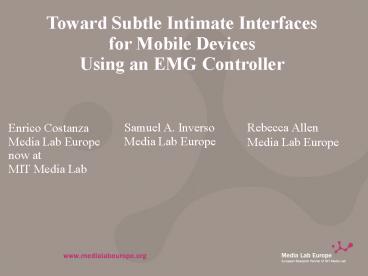Toward Subtle Intimate Interfaces for Mobile Devices Using an EMG Controller
Title:
Toward Subtle Intimate Interfaces for Mobile Devices Using an EMG Controller
Description:
... Interfaces. for Mobile Devices. Using an EMG Controller ... Input devices for disabled users. Affect sensing. Music expression. EMG in CHI (Related Work) ... –
Number of Views:532
Avg rating:3.0/5.0
Title: Toward Subtle Intimate Interfaces for Mobile Devices Using an EMG Controller
1
Toward Subtle Intimate Interfaces for Mobile
Devices Using an EMG Controller
Enrico Costanza Media Lab Europe now at MIT
Media Lab
Samuel A. Inverso Media Lab Europe
- Rebecca Allen
- Media Lab Europe
2
Outline
- Motivation Subtle and hands-free interaction
- EMG as a solution
- An EMG-based controller
- Design approach
- Formal user study
- Conclusion
3
Importance of Subtlety in Mobile Interfaces
- Mobile interaction is often in public spaces
- Subtle interfaces do not disrupt the
environment - Intimate interaction only for the user
- Ringing vs. vibrating alert
4
Importance of Subtlety in Mobile Interfaces
- Speech recognition and evident gesturing
- can be inappropriate
5
Design for Hands-free Interaction
6
Design for Hands-free Interaction
Eyeglass displays
7
Electromyogram (EMG) as a Novel Solution
- Electrical signal from muscle activity
- Can measure isometric activity subtle or no
movement - Surface Electrodes (EKG-like)
- Non-contact sensing (future)
8
EMG in CHI (Related Work)
- Prosthesis control
- Input devices for disabled users
- Affect sensing
- Music expression
9
EMG and MovementLimitation or Advantage?
- EMG and movement are not always related
- Tanaka Knapp report this as a limitation
- We think it is an advantage!
10
Motionless Gestures
- EMG greatest potential for mobile HCI
- Sense subtle gestures
- Example brief contraction of the bicep
11
EMG-based Controller
- Self-contained in armband
- Integration with Bluetooth devices
- (e.g. Phones and PDAs)
- No calibration for individual users
12
Design Process
- The gesture should be
- Natural to perform
- Different from normal muscle activity
- User centered iterative approach
- 1. Select muscle generic gesture definition
- (non-detailed description to subjects)
- 2. Definition refinement, model and algorithm
- 3. Tuning
13
Formal User Study
- Realistic controlled environment subjects
walked - around obstacles in trafficked walkway
- 10 subjects
- Audio stimuli and feedback
- Is training avoidable? (minimal feedback)
- Push the limit short and long contractions
14
Results
- 96 correct recognition
- No false positives
- No training necessary in 7 out of 10 cases
- Cannot distinguish short and long contractions
- across different subjects
15
Discussion
- EMG can be successfully used (96)
- Generally no training required
- No calibration across users
16
Discussion
- Cannot distinguish short and long contractions
- Subjective definition of short and long
17
Future Work
- Test in more complex scenarios
- Measure subtleness
- Improve algorithm
- Use more muscles (alphabet definition)
18
Summary and Conclusion
- Subtle interaction for mobile devices
- New reason to use EMG in CHI
- Motionless gestures
- It works (96 correct recognition no false
positives)































